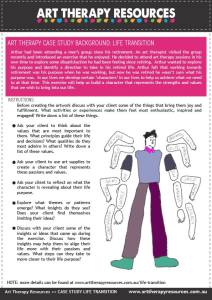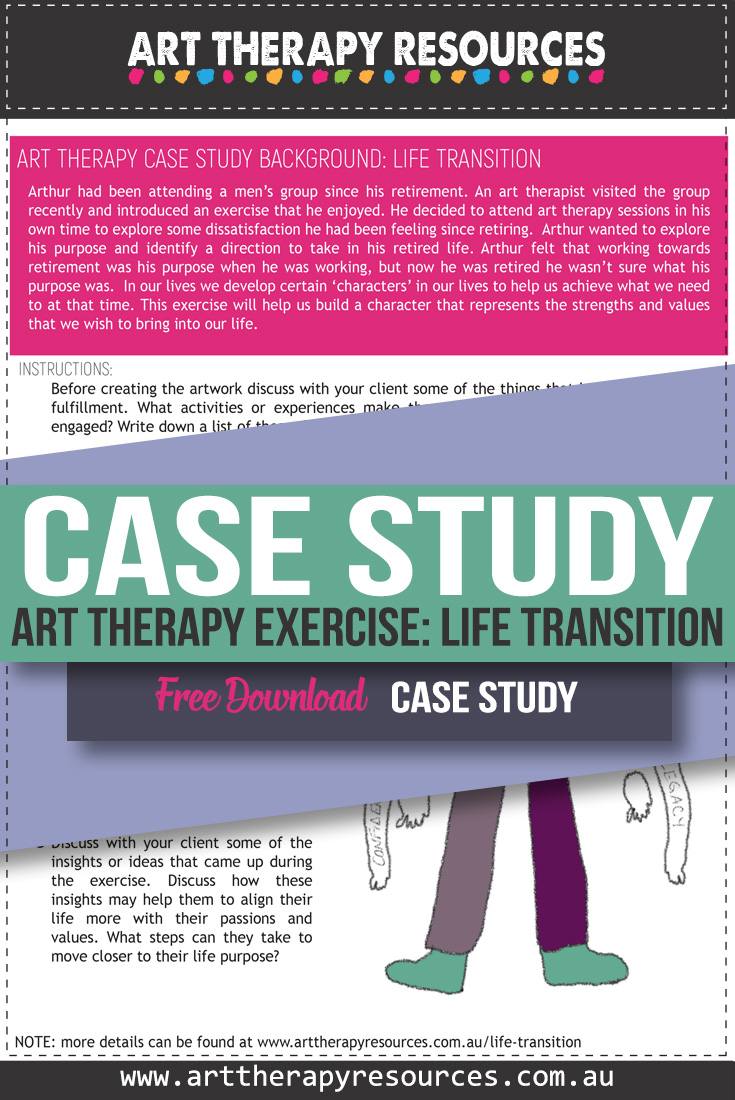THIS POST INCLUDES:
- Art Therapy and Life Stages
- About the Client
- Art Therapy Exercise
- Client Insight and Outcomes
- Disclaimer
- FREE DOWNLOAD Art Therapy Exercise
ART THERAPY AND LIFE STAGES
We also experience events that form the understanding we have of how we exist within our social world. We form new relationships and those relationships in turn influence how we view ourselves and others around us.
BASIC STAGES OF LIFE
There are different ways to conceptualize the stages of life, but one commonly used framework is Erik Erikson’s stages of psychosocial development.
According to Erikson, there are eight stages of development that individuals go through from infancy to old age. These stages are:
- Trust vs. mistrust (infancy): During this stage, infants learn to trust or mistrust their caregivers based on the consistency and responsiveness of their interactions.
- Autonomy vs. shame and doubt (toddlerhood): Toddlers develop a sense of independence and self-control, but may experience shame and doubt if they are overly restricted or criticized.
- Initiative vs. guilt (preschool): Preschoolers explore their environment and develop a sense of initiative, but may feel guilty if they are punished or criticized for their curiosity.
- Industry vs. inferiority (elementary school): Children begin to acquire academic and social skills and develop a sense of competence, but may feel inferior if they do not measure up to their peers.
- Identity vs. role confusion (adolescence): Adolescents seek to establish a sense of identity and personal values, but may experience confusion or anxiety if they are unable to do so.
- Intimacy vs. isolation (young adulthood): Young adults seek intimate relationships and commit to long-term partnerships, but may feel isolated or disconnected if they are unable to form close relationships.
- Generativity vs. stagnation (middle adulthood): Adults seek to contribute to society and make a positive impact on future generations, but may feel stagnant or unfulfilled if they do not achieve their goals.
- Integrity vs. despair (late adulthood): Older adults reflect on their life experiences and seek a sense of meaning and acceptance, but may experience despair or regret if they feel they have not lived a fulfilling life.
These stages are not fixed or rigid, and individuals may experience them differently depending on their personal circumstances and cultural context. However, they provide a useful framework for understanding the different challenges and opportunities that individuals face at different stages of life.
HOW ART THERAPY CAN HELP WITH VARIOUS LIFE STAGES
During our life, we experience different thoughts and emotions about ourselves as we age, however, we also experience events in our life that typically occur at different ages.
For young people, these significant events can be things like learning difficulties, bullying, and identity issues.
For adults, these experiences can be things like a midlife crisis, infidelity, divorce, and fertility issues.
For older adults, these experiences can be things like chronic illness, fatigue, grief and guilt about the past.
Regardless of age, art therapy can also help with general human issues such as family dynamics, emotional overwhelm, social anxiety, and trust issues.
As mentioned in our previous blog post Exploring Your Life Satisfaction with Art Therapy, therapy can be viewed in the context of a client seeking reprieve from emotional or psychological distress, however, the nature of creativity also means that art therapy can facilitate exploration of self-expression, and skill building. This means art can provide significant benefits even on our best days as well as our worst.
Some themes, or ideas, to consider exploring based on the previously discussed categories of life satisfaction include:
- Relationships (family and friends)
- Reflect on a positive relationship in your life and express that relationship using colours, shapes, and textures in an artwork
- Connection
- Create an artwork while sitting outside in nature to help form a connection with art, nature, and relaxation
- Self-expression
- Create an artwork that portrays your inner-self
- Emotional release
- Reflect on how you are feeling now and translate that feeling to an artwork using shapes, colours, textures etc
- Create an emotional clock that reflects on the change in your emotions throughout a day. Does any specific experience or activity you engage in alter your emotions?
- Purpose – includes work
- Create an artwork that invents a new animal, flower, or object. Let yourself creatively imagine a new idea!
- Wellbeing – cognitive and physical
- Create while listening to music and let the music guide your artistic choices
- Create an artwork that reflects a safe and supportive space that you can relax in
- Psychological growth
- Create a collage of all your worries and stress. Transform that artwork into a new image using art supplies that reflect how you might overcome or work through these concerns.
Art therapy has a unique position in aiding the exploration of life satisfaction. Our art making is unique to us and therefore we can use art making to explore and gain deeper insights into our personality and approach to thinking about our lives.
Art therapy encourages us to disconnect from judgmental thinking and fear-based decisions. It encourages us to release our inhibitions so that we may help ourselves through compassion and self-acceptance.
Below are some ways in which art therapy can help with life stages:
- CHILDHOOD: Art therapy can help children express themselves and process their emotions in a safe and non-threatening way. It can also help children develop self-esteem, creativity, and problem-solving skills.
- ADOLESCENCE: Art therapy can provide a creative outlet for adolescents to explore their identity, manage stress, and cope with the challenges of puberty and social pressures. https://arttherapyresources.com.au/art-therapy-adolescents
- YOUNG ADULTHOOD: Art therapy can help young adults explore their sense of self, clarify their values, and develop coping skills for navigating adult responsibilities and relationships.
- MIDDLE ADULTHOOD: Art therapy can help adults cope with the stress of work and family responsibilities, address issues related to aging and physical changes, and promote self-care and self-exploration. https://arttherapyresources.com.au/midlife-crisis
- LATE ADULTHOOD: Art therapy can provide a way for older adults to reflect on their life experiences, process feelings related to loss and mortality, and maintain a sense of purpose and connection.
Overall, art therapy can be a valuable tool for individuals at different life stages to enhance their emotional well-being, develop self-awareness, and foster creativity and self-expression
ABOUT THE CLIENT
- Name: Arthur
- Age: 65
CURRENT CLIENT ISSUES:
Arthur had been attending a men’s group since his retirement. An art therapist visited the group recently and introduced an exercise that he enjoyed. He decided to attend art therapy sessions in his own time to explore some dissatisfaction he had been feeling since retiring.
Arthur wanted to explore his purpose and identify a direction to take in his retired life. Arthur felt that working towards retirement was his purpose when he was working, but now he was retired he wasn’t sure what his purpose was.
ART THERAPY EXERCISE
INSTRUCTIONS:
Before creating the artwork discuss with your client some of the things that bring them joy and fulfillment. What activities or experiences make them feel most enthusiastic, inspired and engaged? Write down a list of these things.
- Ask your client to think about the values that are most important to them. What principles guide their life and decisions? What qualities do they most admire in others? Write down a list of these values.
- Ask your client to use art supplies to create a character that represents these passions and values.
- Ask your client to reflect on what the character is revealing about their life purpose.
- Explore what themes or patterns emerge? What insights do they see? Does your client find themselves limiting their ideas?
- Discuss with your client some of the insights or ideas that came up during the exercise. Discuss how these insights may help them to align their life more with their passions and values. What steps can they take to move closer to their life purpose?
CLIENT INSIGHT AND OUTCOMES
Arthur drew a character with multiple arms to represent the various ways he wanted to reach out to others to help them develop their own confidence.
Arthur felt like this exercise gave him some insight into what aspects of his previous life could be carried into the next phase of his life. Arthur felt like he had more direction to now explore to develop some purpose in his life.
Through this discussion, Arthur also realised that ‘retirement’ does not have to mean only doing hobbies but instead, retirement purely means he now has the time to explore his personal passions and values in life.

DISCLAIMER
FREE DOWNLOAD: Art Therapy Exercise

BUILD YOUR ART THERAPY REFERENCE MATERIALS:
Pin this image to your Pinterest board.

SHARE KNOWLEDGE & PASS IT ON:
If you’ve enjoyed this post, please share it on Facebook, Twitter, Pinterest. Thank you!
